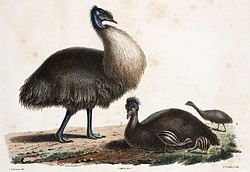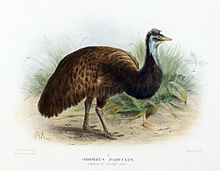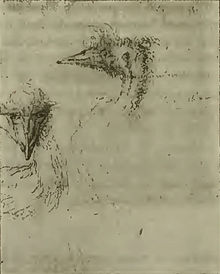- Kangaroo Island Emu
-
Kangaroo Island Emu 
Illustration by Charles-Alexandre Lesueur, based on life-drawings made during Baudin's journey and specimens kept at Jardin des Plantes. The animals were thought to be a male and female of the same species, but are now believed to be a Kangaroo Island Emu and King Island Emu[1] Conservation status Scientific classification Kingdom: Animalia Phylum: Chordata Class: Aves Superorder: Paleognathae Order: Struthioniformes Family: Casuariidae Genus: Dromaius Species: †D. baudinianus Binomial name Dromaius baudinianus
Parker, 1984[3]Synonyms Casuarius diemenianus Jennings,1827
Dromaius parvulus Mathews,1901
Dromaius peroni Rothschild,1907
Peronista peroni Mathews,1913
Peronista diemenianus Mathews,1927Kangaroo Island Emu or Dwarf Emu[3] (Dromaius baudinianus) is an extinct member of the bird family Casuariidae. It was restricted to Kangaroo Island, South Australia, which was known as Ile Decrés by the members of the Baudin expedition. It differed from the mainland Emu mainly in its smaller size. The species became extinct in approximately 1827.[4]
Contents
History
 Restoration of D. parvulus, now a synonym of D. baudinianus, by Keulemans and Henrik Grönvold
Restoration of D. parvulus, now a synonym of D. baudinianus, by Keulemans and Henrik Grönvold
It was discovered in 1802 by Matthew Flinders and reported to be quite common around Nepean Bay. The first bones of the species were discovered in 1903 at The Brecknells, sandhills on the west side of Cape Gantheaume. Initially there was confusion regarding the taxonomic status and geographic origin of the Kangaroo Island Emu, particularly with respect to their relationship to King Island Emu, which were also transported to France as part of the same expedition. The expeditions logbooks failed to clearly state where and when dwarf emu individuals were collected. This led to both taxa being interpreted as a single taxon and that it originated from Kangaroo Island. More recent finds of sub-fossil material and subsequent studies on King and Kangaroo Island Emu confirm their separate geographic origin and distinct morphology.[5] Due to this confusion, it only received its current scientific name in 1984, after a thorough revision of the extinct emus by Shane A. Parker. He based it on a sub-fossil specimen from Kangaroo Island, South Australia.[3][6] Specimen SAM B689Ib, a left tarsometatarsus, is the holotype.[7]
The species is known only from historical observer accounts and from bones, including sets deposited at the South Australian Museum. A mounted skin at the Geneva Museum in Switzerland is sometimes identified as that of a Kangaroo Island Emu, but may instead be a young mainland Emu.
It is believed that this emu lived in the interior forest.[8]
The species' extinction has been attributed to hunting and habitat clearance through burning.[9]
Footnotes
- ^ http://www.euppublishing.com/doi/abs/10.3366/E0260954109001661
- ^ BirdLife International
- ^ a b c Davies, S. J. J. F. (2003)
- ^ Stattersfield et al. 1998.
- ^ http://www.ploscollections.org/article/info%3Adoi%2F10.1371%2Fjournal.pone.0018728;jsessionid=8593CC71DF4BE9E5F5F05C57056D22F0.ambra02
- ^ http://www.birdssa.asn.au/SAOpdf/Volume%2031/1993V31P148.pdf
- ^ Parker S (1984) The extinct Kangaroo Island Emu, a hitherto-unrecocnized species. Bulletin of the British Ornithologists' Club 104: 19–22.
- ^ BirdLife International (2008)(a)
- ^ Garnett 1993.
References
- BirdLife International (2008). Dromaius baudinianus. In: IUCN 2008. IUCN Red List of Threatened Species. Downloaded on 28 December 2008. Database entry includes justification for why this species is considered extinct
- BirdLife International (2008(a)). "Kangaroo Island Emu - BirdLife Species Factsheet". Data Zone. http://www.birdlife.org/datazone/species/index.html?action=SpcHTMDetails.asp&sid=9783&m=1. Retrieved 06 Feb 2009.
- Davies, S.J.J.F. (2003). "Emus". In Hutchins, Michael. Grzimek's Animal Life Encyclopedia. 8 Birds I Tinamous and Ratites to Hoatzins (2 ed.). Farmington Hills, MI: Gale Group. pp. 83–87. ISBN 0 7876 5784 0.
External links
- Species profile at the Australian Government's Department of Environment and Heritage website
- Species page at The Extinction Website
Further reading
- Baxter, Chris (1995): An Annotated List of the Birds of Kangaroo Island (revised edition). South Australia National Parks and Wildlife Service. ISBN 0-7308-0677-4
- Garnett, S. (1993): Threatened and extinct birds of Australia. Royal Australasian Ornithologists Union
- Parker, Shane A. (1984): The extinct Kangaroo Island emu, a hitherto unrecognised species. Bull. Brit. Ornithol. Club 104: 19-22.
- Stattersfield, Alison J.; Crosby, Michael J.; Long, Adrian J. & Wege, David C. (1998) Endemic Bird Areas of the World: Priorities for Biodiversity Conservation.
See also
Cassowaries and emus (family: Casuariidae) Subfamily Cassowaries (Casuariinae) CasuariusEmus (Dromaiinae) Emu (D. novaehollandiae) (supporting page: †Tasmanian Emu (D. n. diemenensis)) • †Kangaroo Island Emu (D. baudinianus) • †King Island Emu (D. ater) • †D. ocypus†E. guljaruba • †E. gidjuCategories:- IUCN Red List extinct species
- Dromaius
- Casuariidae
- Extinct animals of Australia
- Extinct fauna of South Australia
- Extinct flightless birds
- Kangaroo Island
- Ratites
- Bird extinctions since 1500
- Animals described in 1984
Wikimedia Foundation. 2010.


